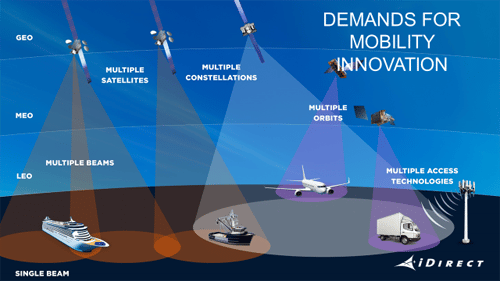 By Kevin Steen, President and CEO, VT iDirect
By Kevin Steen, President and CEO, VT iDirect
This is an excerpt from a recent speech given by Kevin Steen at the 2017 VSAT Congress, an event organized by the Global VSAT Forum (GVF) to bring together industry leaders to discuss upcoming challenges and the innovations that will drive the wider adoption of VSAT.
When you have a single beam, maintaining connectivity for the mobility of ships or planes within that beam is simple. However, modern VSAT networks long ago expanded beyond a single beam. Each step of the way, iDirect has created solutions to keep mobility as seamless as possible.
Demands for Mobility Innovation
First came the need to stitch together multiple beams on the same satellite, so iDirect introduced Fast Beam Switching and switching logic to handle expansion across multiple beams. Then came the need to stitch together multiple satellites, so iDirect introduced Global Bandwidth Management for traffic load balancing.
Now, customers are wanting to combine multiple constellations, such as broad beams from an older satellite with spot beams from a newer satellite, even operating on different frequency bands. And the emergence of MEO and LEO satellites is creating a need to combine and manage connectivity across multiple orbital planes.
Finally, people are seeking to reach past VSAT and integrate with terrestrial 5G for a multi-access network. As you can see, supporting ships, planes or trains has moved far beyond our traditional thoughts about mobility. A new approach is required for bringing together all these differing forms of connectivity on completely separated networks.

Rethinking VSAT: Don’t reinvent, learn from proven Telco solutions
When creating the solution, it’s important that we don’t invent it ourselves and continue the outside world’s view that satellite is a niche technology. Instead, we can learn from the proven mobility solutions of the Telco industry. By aligning with GSM cellular architectures, iDirect can enable operators to integrate networks with different access technologies
This requires creating terminals that can handle multiple waveforms, along with integrating the Evolved Packet Core since that has been successful for IP mobility, and transitioning to virtualized hub infrastructure and software defined networking for scale, cost, and resiliency. Adopting this foundation will allow us to solve many mobility business challenges in a way that is most beneficial to operators.
iDirect is at the forefront of innovation to enable a seamless architecture making it easy for partners to assemble the best solution out of any available assets. We want to empower our customers to expand their reach and service offerings to meet the needs of mobility customers well into the future.